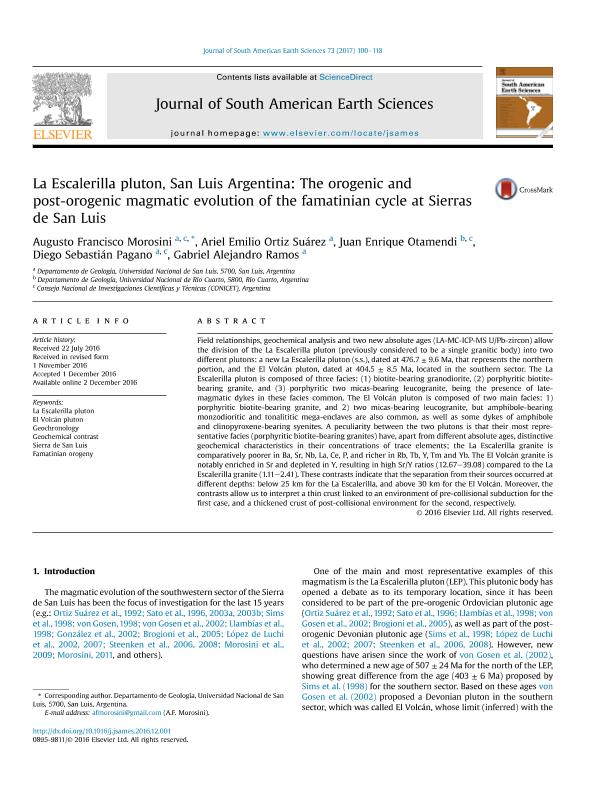Artículo
La Escalerilla pluton, San Luis Argentina: The orogenic and post-orogenic magmatic evolution of the famatinian cycle at Sierras de San Luis
Morosini, Augusto Francisco ; Ortiz Suarez, Ariel Emilio; Otamendi, Juan Enrique
; Ortiz Suarez, Ariel Emilio; Otamendi, Juan Enrique ; Pagano Género, Diego Sebastián
; Pagano Género, Diego Sebastián ; Ramos, Gabriel Alejandro
; Ramos, Gabriel Alejandro
 ; Ortiz Suarez, Ariel Emilio; Otamendi, Juan Enrique
; Ortiz Suarez, Ariel Emilio; Otamendi, Juan Enrique ; Pagano Género, Diego Sebastián
; Pagano Género, Diego Sebastián ; Ramos, Gabriel Alejandro
; Ramos, Gabriel Alejandro
Fecha de publicación:
01/2017
Editorial:
Pergamon-Elsevier Science Ltd
Revista:
Journal of South American Earth Sciences
ISSN:
0895-9811
Idioma:
Inglés
Tipo de recurso:
Artículo publicado
Clasificación temática:
Resumen
Field relationships, geochemical analysis and two new absolute ages (LA-MC-ICP-MS U/Pb-zircon) allow the division of the La Escalerilla pluton (previously considered to be a single granitic body) into two different plutons: a new La Escalerilla pluton (s.s.), dated at 476.7 ± 9.6 Ma, that represents the northern portion, and the El Volcán pluton, dated at 404.5 ± 8.5 Ma, located in the southern sector. The La Escalerilla pluton is composed of three facies: (1) biotite-bearing granodiorite, (2) porphyritic biotite-bearing granite, and (3) porphyritic two micas-bearing leucogranite, being the presence of late-magmatic dykes in these facies common. The El Volcán pluton is composed of two main facies: 1) porphyritic biotite-bearing granite, and 2) two micas-bearing leucogranite, but amphibole-bearing monzodioritic and tonalititic mega-enclaves are also common, as well as some dykes of amphibole and clinopyroxene-bearing syenites. A peculiarity between the two plutons is that their most representative facies (porphyritic biotite-bearing granites) have, apart from different absolute ages, distinctive geochemical characteristics in their concentrations of trace elements; the La Escalerilla granite is comparatively poorer in Ba, Sr, Nb, La, Ce, P, and richer in Rb, Tb, Y, Tm and Yb. The El Volcán granite is notably enriched in Sr and depleted in Y, resulting in high Sr/Y ratios (12.67–39.08) compared to the La Escalerilla granite (1.11–2.41). These contrasts indicate that the separation from their sources occurred at different depths: below 25 km for the La Escalerilla, and above 30 km for the El Volcán. Moreover, the contrasts allow us to interpret a thin crust linked to an environment of pre-collisional subduction for the first case, and a thickened crust of post-collisional environment for the second, respectively.
Archivos asociados
Licencia
Identificadores
Colecciones
Articulos(CCT - CORDOBA)
Articulos de CTRO.CIENTIFICO TECNOL.CONICET - CORDOBA
Articulos de CTRO.CIENTIFICO TECNOL.CONICET - CORDOBA
Articulos(CCT - SAN LUIS)
Articulos de CTRO.CIENTIFICO TECNOL.CONICET - SAN LUIS
Articulos de CTRO.CIENTIFICO TECNOL.CONICET - SAN LUIS
Citación
Morosini, Augusto Francisco; Ortiz Suarez, Ariel Emilio; Otamendi, Juan Enrique; Pagano Género, Diego Sebastián; Ramos, Gabriel Alejandro; La Escalerilla pluton, San Luis Argentina: The orogenic and post-orogenic magmatic evolution of the famatinian cycle at Sierras de San Luis; Pergamon-Elsevier Science Ltd; Journal of South American Earth Sciences; 73; 1-2017; 100-118
Compartir
Altmétricas



